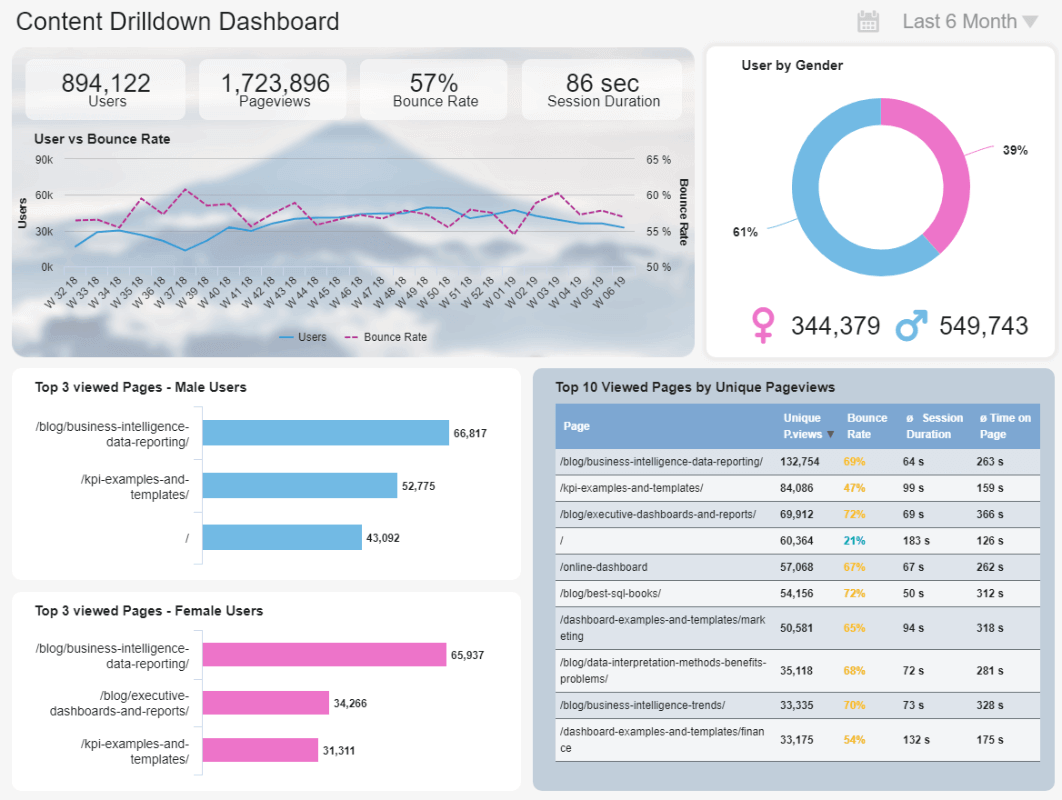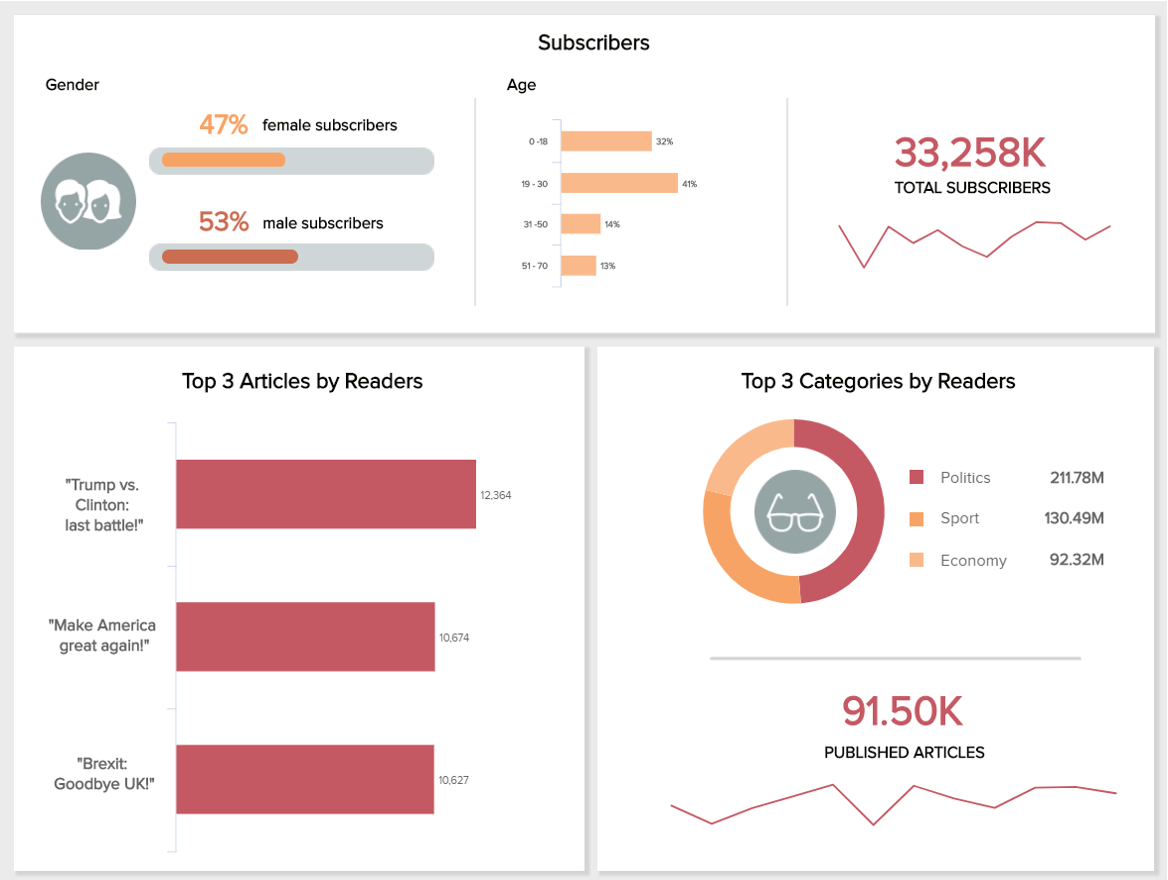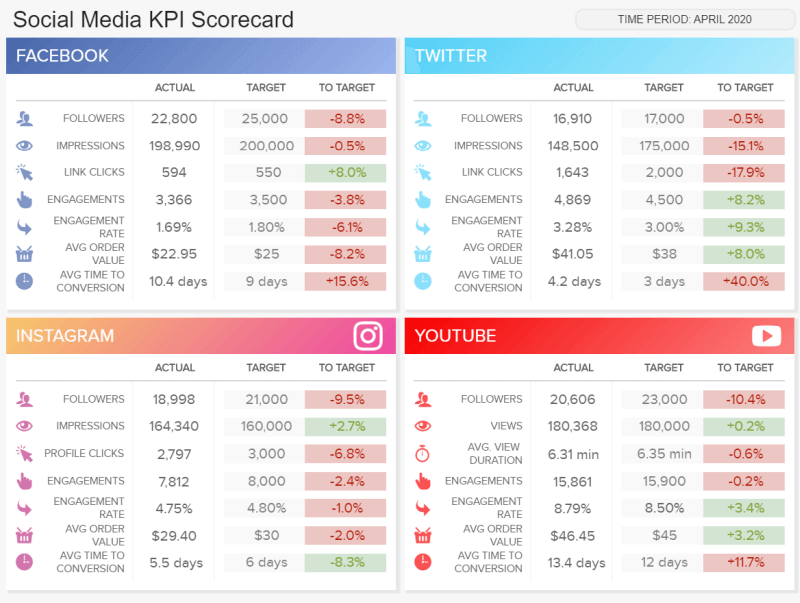A Guide To Performing Successful Content Reporting Using Modern Dashboards
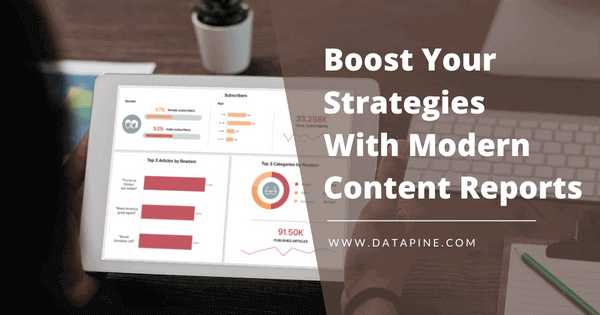
Table of Contents
2) What Is A Content Dashboard?
3) Why Is Content Report Analysis Important?
As a content manager, you most likely spend most of your time writing quality blogs, email newsletters, and social media posts, all in an effort to ensure the business is growing and achieving its goals. That said, measuring the success of your those efforts is another great part of the job, and on many occasions, it can prove to be overwhelming as you need to use multiple tools to gather the data. Enter modern content reports.
Modern content performance reports in the shape of an interactive online dashboard present an intuitive and accessible way to assess your content's success and its ROI in real-time and in one centralized location. To get you started on the topic, we’ve put together this guide including definitions, benefits, examples, and a list of best practices. Let’s get started!
What Is Content Reporting?
Content reporting is the process in which marketers analyze data from Web Analytics, Social Media channels, blog interactions, and more to evaluate the success of their content. Like this, they define what is working and what isn't and improve their strategies to succeed.
For decades, businesses have been approaching the reporting process with static tools that make it way more difficult to extract insights at an appropriate time. This is no longer the case, thanks to the introduction of modern reporting tools such as interactive dashboards. Which we present below.
What Is A Content Dashboard?
A content dashboard is an analytical tool that contains critical performance metrics to assess the success of all content-related initiatives. Armed with real-time data, marketers and content managers can inform their strategies and meet all their content marketing goals.
The value of a content performance dashboard lies in its interactivity and accessibility. When building content for different channels, it is fundamental to be able to make swift decisions that align with what the audience wants as this is the path to be successful. Modern dashboard software provides you with the necessary tools to visualize all your most important sources of information in a centralized location. This way, you are able to spot any issues as well as improvement opportunities to make the most out of your resources and reach your goals in the process.
Now that we’ve gone through some critical definitions, let's look at why analyzing your content can be a successful practice.
Why Is Content Report Analysis Important?
A content analysis template allows you to present relevant information in a way that is understandable and accessible, it serves as a perfect tool not only to assess internal performance but also to show investors, managers, or clients how the strategies are performing. Some other benefits include:
- Create content that actually is performing: Shooting in the dark when deciding which type of content you will deliver to your audience is no longer possible in today’s fast-paced world. A content analysis report is a perfect tool to get a 360-view of what kind of topics, formats, and frequency your audience enjoys the most and generate content that is targeted to them. By looking at relevant KPI metrics to track progress against specific goals, you can make sure to focus only on the work that is successful and avoid investing your efforts into underperforming areas o areas that are not related to your objectives. This is a great way to maximize your time and resources using real-time data.
- Boost content ROI: By building informed data-based strategies from the insights gathered from your content reports, you will be able to generate content that is likely to be successful. In time, this will not only save your business time and money on generating useless content but will also maximize your ROI by making the most out of the resources available to you.
- Increase brand awareness and loyalty: Customers are demanding that brands anticipate their needs and wants more than ever. By analyzing your audience behaviors using a business dashboard, you will be able to generate pieces of content that are aligned with what your customers expect from you. In turn, you will see an increase in awareness and loyalty levels that will also significantly improve your ROI as well as the chances of loyal customers recommending you to friends and family.
- Keep clients and team informed: Last but not least, from an internal perspective, a content report template can also prove to be incredibly valuable. Rather you are an agency working with multiple clients or a marketing team for a corporation, using content reports and dashboards to keep every relevant stakeholder informed about the latest developments is an invaluable approach. These modern reports are easy to share and understand, making them the perfect tools to support discussions and foster collaboration.
Try our modern content reporting software for 14 days, completely free!
Content Dashboard Examples & Templates
To put the value of content reporting tools into perspective, we will now present a list of examples that you can use to measure your content KPIs in an efficient way. As mentioned before, these dashboards offer data from multiple sources into one single location and can be drilled to explore lower levels of information and extract deeper conclusions.
1. Content Drilldown Dashboard
**click to enlarge**
Our first example is the perfect overview for a company that is generating big amounts of content on its website and wants to assess its success. This most insightful of Google Analytics dashboards provide the perfect mix between overview metrics and more detailed insights. On the top, you can see a graph tracking the weekly development of the website’s users, page views, bounce rate, and session duration, and on the bottom right corner, you can see these metrics tracked by specific pages. Having the possibility to drill down into lower levels of data to understand the reasons behind the numbers is an invaluable practice, especially when it comes to generating content that is targeted to your audience. Let’s look at some of these indicators in more detail below.
- Bounce rate: The bounce rate indicates the percentage of people that entered your website through a particular page and left without clicking on any other pages. A high bounce rate can indicate that your website is not engaging enough to keep users interested which can also affect the visibility of your content. On the other side, it can also mean that the page they initially viewed answered their question efficently, which is why this rate needs to be analyzed in detail to find the reasons behind it.
- Session duration: Your content efforts are important not only to drive traffic to your website but also to keep users engaged for as much time as possible since the longer they stay, the more likely are they to come back. The average session duration will tell you which type of content or pages are keeping users engaged for the most time and which ones are not that interesting so you can optimize accordingly.
- User by gender: Learning your share of the user's gender is another technique that can help you boost your strategies. By knowing what type of audience enjoys your work the most, you can make sure you are providing them with the best experience and knowledge possible. You can also drill down into lower levels of data such as the top pages by female and male users and extract deeper conclusions from them.
2. Content Quality Control Dashboard
**click to enlarge**
Assessing content quality is not an easy task as it can be a subjective process. That said, there are a few indicators that can help you get an idea of how your work is perceived and in which areas it could be improved. The example above, helps you do just that by providing insights into the different interactions your content has. In this case, our digital media dashboard is focusing on written pieces such as blog posts and it includes KPIs such as the top 5 articles by likes, the average comments per article, the subscribers gained, and the story turnaround time. Let’s look at some of these metrics in more detail below.
- Story turnaround time: This indicator is not exclusive to online publications, it has been used for decades in the publishing industry to measure the time since an article is approved to the time it is actually published. It can help you optimize each stage to make the process as efficient as possible.
- Flesch reading ease: The Flesch reading ease is a readability test developed in the U.S and used by different content marketing reporting tools to assess the level of readability of a text. While this indicator might be subjective, it is a good reference to evaluate how easy to read your articles are. You can set a benchmark for your articles and evaluate them accordingly.
- Articles interactions: Interactions such as likes, shares, and comments are the best way to assess the quality of your content. In the end, you want your articles to have the most interactions as this means the audience is enjoying them. Tracking interactions closely will not only allow you to understand which type of articles and topics your customers like the most, but will also help you understand the level of engagement and loyalty.
3. Readers Insights Dashboard
**click to enlarge**
As mentioned throughout this post, getting to know your audience on a deeper level is a fundamental practice when it comes to building successful content marketing strategies. For this purpose, our digital media dashboard example above provides you with the necessary insights to understand audience demographics and preferences in a complete way.
- Top categories by readers: This is a straightforward indicator that will help you understand which topic categories are the most interesting for your readers. This is a particularly useful metric for a website that writes about a wide range of topics as it can help narrow the focus on the ones with the most potential.
- Top articles by readers: A drill down into the top categories can let you understand which specific topics and articles from that category are the most successful ones. By looking at this metric, together with the rest of the indicators on this content metrics dashboard, you will be able to build a complete picture of what readers are looking for on your website.
- Readers by gender and age: While knowing the ages and genders of your audience is a valuable tool, these indicators prove to be even more useful when put together as this will help you build an accurate picture of what your target audience looks like. As seen in the image above, we can see that this business has a high rate of females and males between the ages of 25-34 which is a good place to start building around.
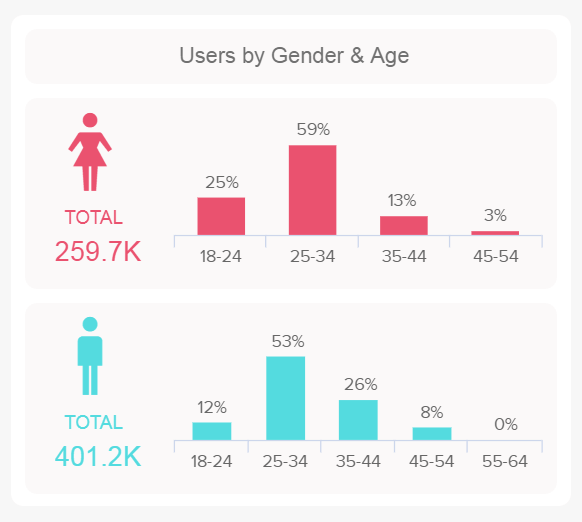
4. Social Media Content Performance Dashboard
**click to enlarge**
Social media channels are the ultimate tools used to share content and redirect traffic to your website. That being said, our next example focuses on 4 social media channels (Facebook, Instagram, Twitter, and YouTube) and how they perform in real-time. Each of these indicators is tracked against a target, negative numbers are marked in red and positive ones are marked in green to quickly understand if anything is underperforming.
- Engagement rate: The engagement rate is used as a success factor when it comes to social media content as it includes any type of interaction such as likes, shares, comments, clicks, and others in its calculation. It is a relevant metric to assess the success of your strategies, you can track it for the different channels and types of content (e.g. paid or organic) and understand where you should focus your efforts.
- Average time to conversion: The conversion time is one of the most important metrics from this social media dashboard. Ultimately, you are generating all of your content with the aim of converting it into positive business results such as new clients or increased sales. That said, conversions can look differently depending on the aim of your strategies, it is important to use this indicator as a performance metric for the success of your content.
5. C-level Content Marketing Reporting
The bottom line of all your content marketing activities is to bring more customers to the organization and maximize ROI in the process. This is especially true considering that 79% of companies use content marketing to generate quality leads. These goals are what c-level executives are expecting from the marketing team and what should be included in a report that is aimed at them. So far, we’ve covered examples of how to assess the quality of your strategies and work. Now, let’s look at some high-level indicators to evaluate the success of those efforts.
- Website-traffic-to-lead-ratio
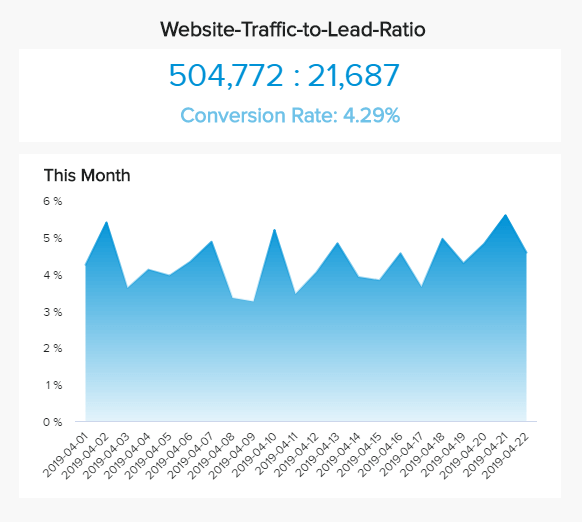
The website traffic-to-lead ratio tracks the number of website visitors that have turned into actual leads. Naturally, the final goal of generating quality content on your site is to turn visitors into paying customers. That said, this rate should be as high as possible. A low rate could mean your website is failing at targeting new customers.
- Cost per lead (CPL)
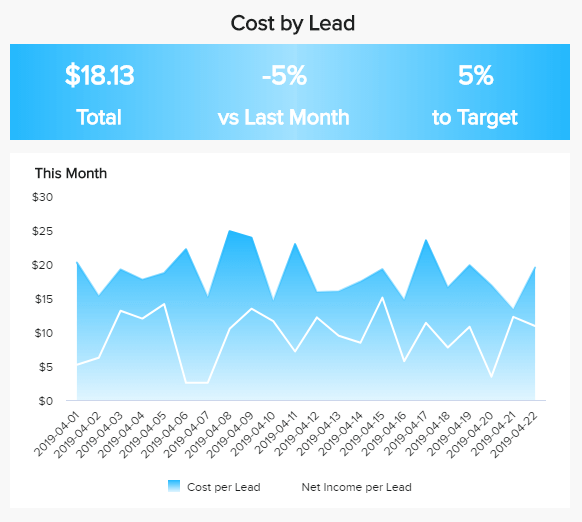
Moving on in the process, once you have an idea of your lead rate, you also need to think about the costs. By quantifying how much it costs to score a potential customer, marketers can better allocate resources and budget for different strategies and campaigns. For better insights, this indicator can be broken down into different channels to get a bigger picture of which areas are most profitable. This leads us to our last example.
- ROI
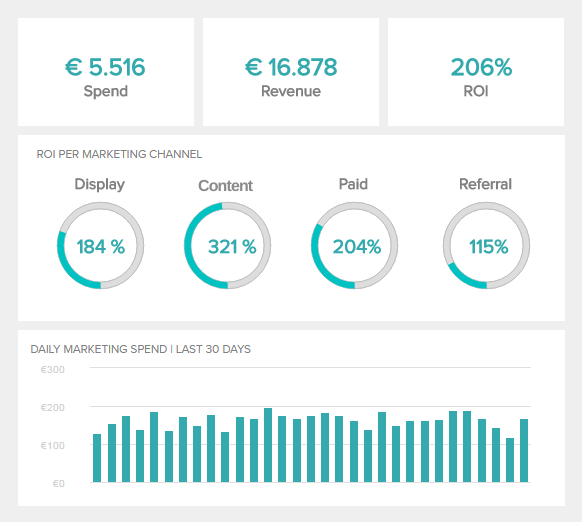
Having a high return on investment is the end goal of your content strategy journey. Given that this indicator is directly tight to revenue, it is one of the most relevant success measurements for the marketing department. A good practice in this regard is to compare the different areas and see which ones are bringing the most rewards. In this case, we can see that content has the highest ROI, which means a successful strategy.
Content Reporting Best Practices
Now that we looked at some examples, you might feel ready to generate your own content reports. To help you with this quest, here are a few best practices to follow to successfully analyze your data and generate insightful reports.
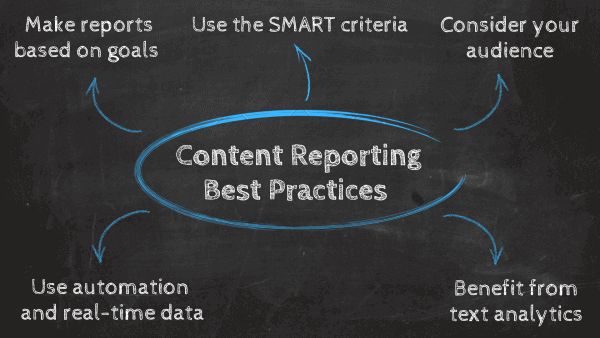
- Make reports based on goals
As a basis, any successful data reporting process should begin with defining clear goals and objectives to use as a guideline to measure performance. In the case of a content strategy, goals should be based on 2 factors: general business objectives, such as increasing sales, and more specific ones, such as increasing organic traffic through SEO strategies.
By setting clear objectives, it is easier to measure the return on investment in an efficient and effective manner. Once your goals are defined, you can start asking yourself questions that you need your dashboard and reports to answer and defining the KPIs you will use to measure your efforts. This leads us to our next point.
- Use the SMART criteria
After you defined general goals, the next step is to select the KPIs you will use to measure the performance of your efforts towards achieving those goals. To do so, it is necessary to avoid choosing vanity metrics that won’t tell you much about your actual progress. A great practice in this regard is to use the SMART criteria. According to it, the KPIs you choose should be: Specific, Measurable, Attainable, Relevant, and Timely. In other words, your KPI should be relevant to your general goals, realistic and attainable considering the business current situation, and measurable in time. If you want to get more insights on the topic, check out our guide on KPI targets and goals.
- Consider your audience
When dealing with content reports it is very likely that you will need to show them to different audiences. For example, a content agency might need to generate a client report for different clients about the latest developments in their strategies. On the other hand, a marketer might need to show reports to the CMO or to the rest of the team to support meetings and discussions. That being said, considering the needs of each audience is a great practice for a successful reporting process. Here it is necessary to consider what questions your audience needs to answer with the report and which KPIs will help them with that.
- Benefit from text analytics
Benefiting from different technologies to extract the maximum potential out of your data is another best practice that you should follow. Text analytics proves to be especially useful when it comes to assessing the sentiment of your audience towards your content. In short words, text analytics uses machine learning and statistical and linguistic techniques to analyze large amounts of text data such as social media comments and understand if the sentiment is negative, positive, or neutral. This is another way in which you could understand how each piece is perceived and find improvement opportunities.
- Use automation and real-time data
Generating quality content is a time-consuming task. Taking that into account, reporting on the performance of this work can be even more difficult to squeeze in. For this reason, relying on a dashboard creator that includes automation features as well as real-time data is the best option to enjoy all the benefits of content reporting and insights without the tedious task of manually generating them. With an automation tool, your reports are automatically generated and updated with real-time data so you always have the latest developments at your fingertips.
Try our modern content reporting software for 14 days, completely free!
Key Takeaways From Content Reporting
As you’ve seen throughout this post, content reports and dashboards are invaluable tools that provide the necessary knowledge to make informed decisions and generate targeted strategies tailored to your audience preferences.
With a modern data-based approach, you no longer need to shoot in the dark or waste valuable resources on wrongly targeted strategies. A modern BI dashboard software provides you with key features to approach your content data in a way that is user-friendly, accessible, and efficient.
If you are ready to start building your own content reports, then try our online reporting software for a 14-days free trial and benefit from real-time performance tracking today!
